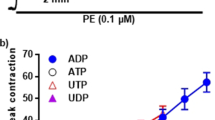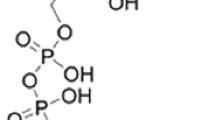Summary
Bovine (BPAEC) and human (HPAEC) pulmonary artery endothelial cell monolayers were incubated with either ATP, ATP analogues, or UTP, followed by measurement of intracellular pH (pHi) and the rate of recovery from acidosis. ATP increased baseline pHi and the rate of acid recovery in BPAEC. This response was inhibited by the amiloride analogue, methyisobutylamiloride, demonstrating that activation of the Na+/H+ antiport was responsible for the increase in baseline pHi and the recovery from acidosis. This response had the features of both a P2Y and P2U purinergic receptor, based on the responses to a series of ATP analogues and UTP. In contrast, none of the nucleotides had any significant effect on pHi and Na+/H+ antiport activity in HPAEC. This difference in the response to extracellular nucleotides was not due to a difference in ATP metabolism between cell types, since the ectonucleotidase-resistant analogue, ATPγS, also had no effect on HPAEC. Analogues of cAMP had no effect on pHi or acid recovery in either cell type. Incubation of BPAEC and HPAEC with the photoaffinity ligand [32P] 8-AzATP indicated that both BPAEC and HPAEC possess an ATP-binding protein of 48 kDa. However, BPAEC exhibited an additional binding protein of 87 kDa. Thus, the contrasting response to extracellular ATP between bovine and human pulmonary artery endothelial cells may be related to differences in the signal transduction pathway leading to antiport activation, including different ATP-binding sites on the cell membrane.
Similar content being viewed by others
References
Abbracchio, M. P.; Burnstock, F. Purinoceptors: are there families of P2x and P2y purinoceptors? Pharmacol. & Ther. 64:445–475; 1994.
Batlle, D. C.; Peces, R.; LaPointe, M. S., et al. Cytosolic free calcium regulation in response to acute changes in intracellular pH in vascular smooth muscle. Am. J. Physiol. (Cell Physiol.) 264:C932-C943; 1993.
Bo, X.; Simon, J.; Burnstock, G., et al. Solubilization and molecular size determination of the P2x purinoceptor from rat vs. deferens. J. Biol. Chem. 267:17581–17587; 1990.
Boyer, J. L.; Cooper, C. L.; Harden, T. K. [32P]3′-O-(4-benzoyl)benzoyl ATP as a photoaffinity label for a phospholipase C-coupled P2Y purinergic receptor. J. Biol. Chem. 265:13515–13520; 1990.
Bussolino, F.; Wang, J. M.; Turrini, F., et al. Simulation of the Na+/H+ exchanger in human endothelial cells activated by granulocyte and granulocyte-macrophage-colony-stimulating factor. J. Biol. Chem. 264:18264–18287; 1989.
Chandler, A. Regulation of lung surfactant secretion by intracellular pH. Am. J. Physiol. 257:L354-L360; 1989.
Clark, J. D.; Limbird, L. E. Na+/H+ exchanger subtypes: a predictive review. Am. J. Physiol. (Cell Physiol.) 261:C945-C953; 1991.
Cutaia, M. V.; Parks, N. Oxidant stress decreases Na+/H+ antiport activity in bovine pulmonary artery endothelial cells. Am. J. Physiol. (Lung Cell Mol. Physiol.) 267:L649-L659; 1994.
Dawicki, D. D.; McGowan-Jordan, J.; Bullard, S., et al. Extracellular nucleotides stimulate leukocyte adherence to cultured pulmonary artery endothelial cells. Am. J. Physiol. (Lung Cell Mol. Physiol.) 268:L666-L673; 1995.
Dubyak, G. R. Signal transduction by P2-purinergic receptors for extracellular ATP. Am. J. Respir. Cell Mol. Biol. 4:295–300; 1991.
Gerritsen, M. E.; Bloor, C. M. Endothelial cell gene expression in response to injury. FASEB J 7:523–532; 1993.
Giannattasio, B.; Powers, K.; Scarpa, A. Characterization of myocardial extracellular ATP receptors by photoaffinity labelling and functional assays. FEBS Lett. 304:27–31; 1992.
Huang, N.; Wang, K.; Heppel, L. A. Stimulation of aged human lung fibroblasts by extracellular ATP via suppression of arachidonate metabolism. J. Biol. Chem. 268:10789–10795; 1993.
Kitazono, T.; Takeshige, K.; Cragoe, E. J. J., et al. Intracellular pH changes of cultured bovine aortic endothelial cells in response to ATP addition. Biochem. Biophys. Res. Comm. 152:1304–1309; 1988.
Kitazono, T.; Takeshige, K.; Cragoe, E. J., et al. Involvement of calcium and protein kinase C in the activation of the Na+/H+ exchanger in cultured bovine aortic endothelial cells stimulated by extracellular ATP. Biochim. Biophys. Acta 1013:152–158; 1989.
Kitazono, T.; Takeshige, K.; Minakami, S. Activation of cultured bovine aortic endothelial cells by extracellular pyrimidine triphosphate. Int. J. Biochem. 24:1323–1327; 1992.
Laemmli, U. K. Cleavage of structural proteins during assembly of the head of bacteriophage T4. Nature 227:680–685; 1970.
Lustig, K. D.; Shiau, A. K.; Brake, A. J., et al. Expression cloning of an ATP receptor from mouse neuroblastoma cells. Proc. Natl. Acad. Sci. 90:5113–5117; 1993.
Motte, S.; Pirotton, S.; Boeynaems, J. M. Heterogeneity of ATP receptors in aortic endothelial cells: involvement of P2Y and P2U receptors in inositol phosphate response. Circ. Res. 72:504–510; 1993.
Na+/H+ Exchange. Grinstein, S., ed. Boca Raton, FL: CRC Press; 1988.
Pirotton, S.; Motte, S.; Cote, S., et al. Control of endothelial function by nucleotides: multiple receptors and transduction mechanisms. Cell. Signalling 5:1–8; 1993.
Ryan, U. S.; Clements, E.; Habliston, D., et al. Isolation and culture of pulmonary artery endothelial cells. Tissue & Cell. 10:535–554; 1978.
Thomas, J. A.; Buschbaum, R. N.; Zimniak, A., et al. Intracellular pH measurements in Ehrlich ascites tumor cells utilizing spectroscopic probes generated in situ. Biochemistry 18:2210–2218; 1979.
Tse, M.; Levine, S.; Yun, C., et al. Structure/function studies of epithelial isoforms of mammalian Na+/H+ exchanger gene family. J. Membr. Biol. 135:93–105; 1993.
Wilkinson, G. F.; Purkiss, J. R.; Boarder, M. R. The regulation of aortic endothelial cells by purines and pyrimidines involves co-existing P2Y purinoceptors and nucleotide receptors linked to phospholipase C. Br. J. Pharmacol. 108:689–693; 1993.
Xing, M.; Thevenod, F.; Mattera, R. Dual regulation of arachidonic acid release by P2U purinergic receptors in dibutyryl cyclic AMP-differentiated HL60 cells. J. Biol. Chem. 267:6602–6610; 1992.
Author information
Authors and Affiliations
Rights and permissions
About this article
Cite this article
Cutaia, M., Dawicki, D.D., Papazian, L.M. et al. Differences in nucleotide effects on intracellular pH, Na+/H+ antiport activity, and ATP-binding proteins in endothelial cells. In Vitro Cell.Dev.Biol.-Animal 33, 608–614 (1997). https://doi.org/10.1007/s11626-997-0110-6
Received:
Accepted:
Issue Date:
DOI: https://doi.org/10.1007/s11626-997-0110-6




